The 3 Main Sources of Home Heating
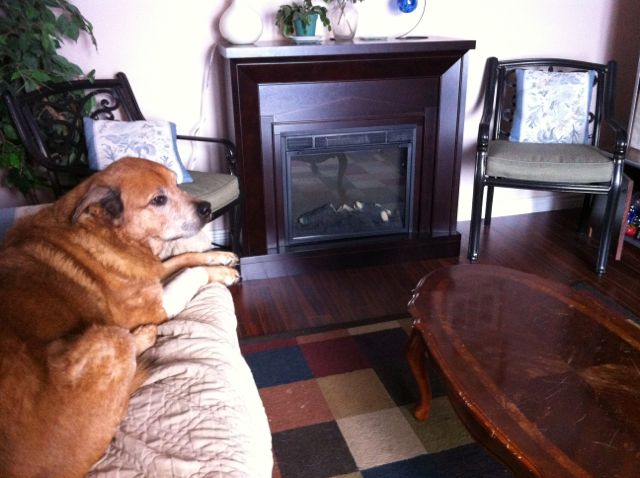
It’s wintertime in the Northern hemisphere and that means we’re heating our homes. The new year started off a bit on the warm side, with the temperature at nearly 70° F (21° C) here in the Atlanta area. In terms of heating degree days (HDD), we’ve gone from about 12 HDD/day at the beginning of the month to 24 HDD/day in the past week. With only four days to go in the month, we’re at 515 HDD and probably won’t hit our average of 684 HDD for January so it may be another down year for heating degree days here.
Still, with temperatures dropping into the low 20s Fahrenheit for the next couple of nights, we’ll have lots of demand for heating in the ATL. And nearly all of that heating will come from one of these three sources.
Combustion
This one’s common in many places that do significant heating. It’s the furnace that extracts the heat from burning natural gas or propane, the boiler burning natural gas or fuel oil, and woodstoves burning wood. Fuels like natural gas (which is mostly methane), propane, fuel oil, and wood contain chemical energy. The process of combustion releases that energy in the form of heat. Then the heat is distributed through the living space with air ducts and hydronic tubes.
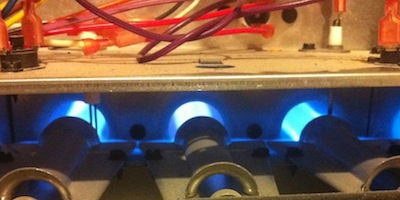
Burning a fuel and using the heat in your home will be less than 100% efficient. Furnaces, boilers, and woodstoves send exhaust gases up the flue and some of heat of combustion goes right out of the house along with the exhaust.
If you’re a clever person, though, you may be thinking to yourself, “Hold on a minute, Allison. What about unvented space heaters or ventless gas fireplaces inside the living space?” Every BTU of heat stays in the home as there is no flue to carry away the exhaust gases. Right? Not so fast. Actually, a 96% efficient condensing furnace is more efficient than a ventless gas fireplace. The key to understanding that lies in the water vapor created during the chemical reaction of combustion. See my article on the topic for more detail.
But let’s also remember that unvented space heaters of any kind, including ventless gas fireplaces, are a bad idea. Pretty much anyone who understands indoor air quality will tell you they can be a problem even when operating properly because of the water vapor and nitrogen dioxide created.
So in the type of combustion system that has a flue for the exhaust gases, you’ll always lose some heat to the outdoors and thus your efficiency will be less than 100%. The best furnaces and boilers these days are up in the high 90s, though, so you can capture most of that heat. But that doesn’t count what you might lose in distributing that heat if your air ducts or hydronic tubes are not completely in conditioned space.
Electric resistance
Another way to get heat is to move electricity through a type of conductor that has a high electrical resistance. That converts the electricity to heat…and it does so at 100% efficiency. Don’t get too excited about that, though, because the third method below gets more than 100%.
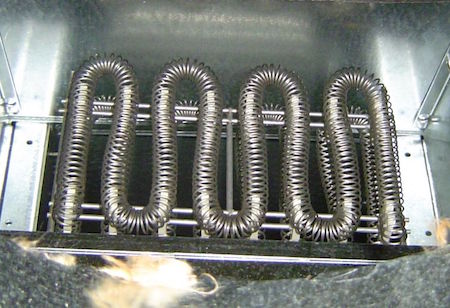
A lot of homes have electric resistance heat (also called strip heat) built into the central forced air HVAC system. That’s the case in the photo above. If it’s used as supplemental heat in a heat pump, it can be OK. If it’s your primary source of heat, your heating bills will be higher than you could be paying because you could get much more heat from that same electricity in a heat pump.
Sometimes that electric resistance heat in a system malfunctions, too. The worst is when it comes on while your air conditioner is running in summer. Not only will your bills be way too high but you may have trouble cooling the house.
Outdoor air, ground, or water
The best way to heat your home is by capturing heat from the outdoor air, ground, or water. (Yes, I do have an opinion.) You may be thinking, how the heck can you get heat from cold outdoor air? Great question! It’s basic physics.
The second law of thermodynamics says that heat flows from warmer objects to cooler objects. If you want to wring heat out of air that’s 20° F, say, you need to have something colder than 20° F in contact with the air. And that’s what heat pumps do.
Regarding efficiency, electric resistance gives you one BTU of heat for each BTU of electricity. (Yeah, electrical energy is measured in kilowatt-hours but both are units of energy and the conversion is straightforward.) With a heat pump, you generally get more than one BTU out for each BTU in. The ratio of BTUs out to BTUs in is typically around 2 or 3 but can be higher with better heat pumps or lower in really cold weather.
Heat pumps do have the drawback of their heating capacity going down as the temperature goes down, and that’s what you need supplemental heat for. As mentioned above, electric resistance is often used as the supplemental heat source in heat pumps but it’s not your only option. A hydronic coil connected to the water heater can be a really good way to provide that extra heat you need on the cold nights.
Also, the technology now is much better than it was in decades past. Inverter-driven mini-split heat pumps can provide their full heating capacity down to the single digits Fahrenheit. We’ve got Mitsubishi mini-split heat pumps in our office in Decatur, Georgia and they’ve been great, even on those days where the temperature has dipped into the 20s. (Disclosure: Mitsubishi is an advertiser here.)
What about solar heating?
Yeah, a few homes are heated with solar energy. Back in the ’70s, that was a thing. Here’s a really cool solar home built in the early ’70s by architect Richard Levine, and which he still lives in. I got to visit him there a few years ago and I can tell you, it’s quite the spectacle.
But capturing solar radiation for heat turned out to be mostly a deadend. As Martin Holladay has shown, superinsulation won the battle between more windows or more insulation (pdf). Now we know it’s better to use that solar radiation to make electricity.
In the end, if you’re wondering where the heat in your home comes from, it’s almost certainly one of the three main sources: combustion, electric resistance, or the outdoor air, ground, or water.
This article was updated on 1/29/19 to correct the original statement about unvented space heaters being 100% efficient. They are not. See the combustion section above.
Related Articles
The Fundamentals of Heating and Cooling Degree Days, Part 1
A Ventless Gas Fireplace Is a Liability
How the Heck Does a Heat Pump Get Heat from Cold?!
NOTE: Comments are moderated. Your comment will not appear below until approved.
This Post Has 24 Comments
Comments are closed.

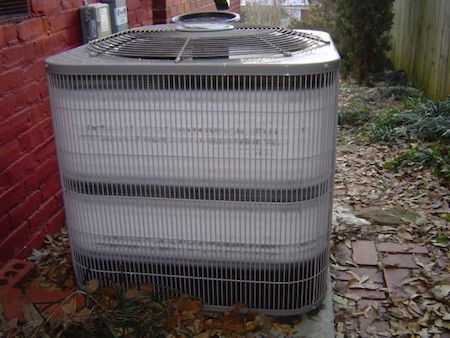
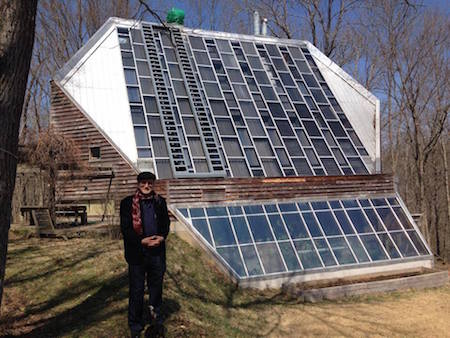
Very interesting. I suppose
Very interesting. I suppose solar heating tubes with a vacuum inside, are more or less extinct?
It’s funny how Reddy Kilowatt is the last man standing.
Mark, no, those evacuated
Mark, no, those evacuated tube solar collectors aren’t quite extinct, but they’re also mainly used for water heating, not space heating. And speaking of solar water heating, Martin Holladay at Green Building Advisor wrote a couple of articles earlier this decade about how even “solar thermal is dead” (2012) and “really, really dead” (2014). Not everyone agrees, but the numbers definitely favor electric heat pump water heating. In some places, even electric resistance water heating beats solar thermal.
Alison, great article. Have
Alison, great article. Have you any thoughts on Solar Air Heat Panels like ones made by SolarSheat which would have no running costs. They may be only supplemental heat. Just curious what you think.
The problem with solar
The problem with solar thermal space heating is the high initial cost. Sure, operating costs are minimal (pump energy), but you still need another heat source since it’s never practical to size thermal solar system to the peak load.
I’ve had the opportunity to compare lifecycle cost for solar thermal vs high efficiency heat pumps on several beyond-code projects and it wasn’t even close. What most folks don’t realize is how much less it costs to heat a home that’s sealed tight and insulated right. I relegate solar thermal space heat to the nerdy DIY market, like Levine’s project pictured in the article.
We’ve installed a few
We’ve installed a few Mitsubishi unit there are supposed to give full heat down to -13F. They’ve worked great down to the single digits, but this week in the Chicago western suburbs is going to be our first real test.
Lee H, the Mitsubishi systems
Lee H, the Mitsubishi systems you mention are probably the HyperHeat models? They provide 100% capacity down to 5*F and ~75% capacity down to -13*F. Indeed, the real test for many systems, including gas and electric utility capacity will be this week in many areas of North America. Waiting for my flight to Chicago as I write this. Crossing fingers for everyone to stay safe and warm.
Oops, I dropped some bad
Oops, I dropped some bad grammar in that first post, anyway just to update. The Mitsubishi “Hyper heat” models performed as they were designed, holding space temperatures around 70F with ambient temperatures into -10F range. At -15F outside room temps were 65F and falling. At below -20F outside, temps bottomed out at 58F on both Wednesday and Thursday AM with the unit providing virtually no heat as far as I could tell.
That’s impressive, Lee. Can
That’s impressive, Lee. Can you tell us more about what you mean by “outside room temps”? If by that you mean rooms on the perimeter of the house, what were the interior room temperatures? And did you have any supplemental heat?
I should have had a comma in
I should have had a comma in that sentence. I meant that when the outside air got to -15F, the room temperatures were at 65F and falling. Indicating that the HyperHeat models appeared to lose capacity very quickly when the ambient temps get below specified -13F. As Shawn mentioned above the capacity loss from +5F to -13F is about 25%. From -13F to -20F it seemed to lose all capacity to heat. The local rep could not give me a capacity at -20F only stating that the units are tested to -13F. The unit is installed on a long line technician spaces with a 300′ west exposure and an interior east wall. There is no supplemental heat in the Mitsubishi indoor indoors and they’re not available if I remember correctly. Plug-in space heaters were used where needed if the occupants where there (everyone was asked to work from home that day if possible). All-in-all, I’m impressed with the HyperHeat models as they did perform well down to below -10F making them a good fit to do all heating in most of the country.
My understanding is that the
My understanding is that the heat pump will shut off at the designated minimum temperature, which would explain the rapid drop in the indoor temp. However, I haven’t had the opportunity to test or witness this. Depending on the climate zone and other circumstances, I advise clients as to the various supplemental heat options. For ductless, that usually means one or more baseboard or portable electric radiators.
Unfortunately, where I live
Unfortunately, where I live the market prices natural gas lower than electricity, so I only use my more efficient heat pump as an air conditioner.
This could be true, but make
This could be true, but make sure you are comparing apples to apples. IOW, adjust your electric cost for the higher efficiency of the heat pump. A heat pump with a Coefficient of Performance of 3 will be more than three times more efficient than a 95% natural gas furnace on a BTU to BTU basis. Of course, the COP varies with the outdoor temperature, so you have to factor that in.
In general, based on a quick Google search (I am sure others have better sources), the cost is about the same for gas vs heat pump. Tack on a PV system and there is no comparison, the heat pump wins. Consider green house gas emissions and the heat pump wins again.
My new tight and well insulated home is 100% heat pump with no back up, other than some sealed gas logs that are more for aesthetics, but could heat the entire house in the event of a power failure.
@Norman, greenhouse emissions
@Norman, greenhouse emissions aside (irrelevant to Nina’s point), it’s not unusual to see natural gas heat beat a heat pump in terms of operational cost. It all depends on the relative cost of NG vs electricity in a given market. For example, I have clients paying around $0.60 cents per therm for NG (therm = 100k BTU). A 90% gas furnace would thus cost around $0.72 per therm of heat output (includes ~5 cents per therm for ECM blower energy).
If electricity costs, say, 12 cents a kWh, that works out to $3.52 per therm equivalent (i.e., 100000 BTU / 3414 BTU per kWh). A mid-efficiency heat pump (16 SEER) has a COP-47F of around 3.7 to 4.0 and a COP-17F of around 2.4 to 2.6. The seasonal average will be somewhere in between. Taking your 3.0 COP assumption, the heat pump would cost around $1.17 per therm output before factoring in supplemental heat.
In markets without access to natural gas, heat pumps are nearly always a no-brainer. The only question becomes how to provide supplemental heat, or if it’s even necessary. In doing this analysis, it’s important to get a handle on the anticipated supplemental fraction (easier said than done). One thing that surprises most folks is how useful a heat pump can be in cold climates. The fact is, the colder the climate, the more heating hours there are in the temperature range where a heat pump can handle the entire load. Heat pumps are beginning to make inroads in Maine and Alaska.
David,
David,
I absolutely agree; it depends on the rate structure for your area. In my area the NG company charges a $10 base rate plus $0.88 a therm. An Energy Star rated all electric house costs $8.29 base rate plus $0.828 a KWH.
Using your numbers, a 90% furnace works out to $1.06 a therm. The KWH rate converts to $2.43 a therm, so anything with a COP over 2.29 is a winner.
Nice article. The first note
Nice article. The first note I have is that those ventless combustion appliances still aren’t 100% efficient because there will never be 100% combustion — meaning that some carbon will still be tied up in CO and other hydrocarbons that occupants then breathe.
An important thing to point out with electric heating is that its effective efficiency depends on the electric utility’s portfolio. Electric resistance heat may be 100% efficient in converting electricity to heat, but if that is generated by a 40% efficient coal plant, it’s an important distinction.
Cold climate heat pumps can do a really good job at temperatures into the negative degrees F. NEEP publishes a list of requirements and a database of (many!) compliant heat pumps at https://neep.org/initiatives/high-efficiency-products/emerging-technologies/ashp/cold-climate-air-source-heat-pump.
Brian J: What you say is
Brian J: What you say is technically correct, but practically all vented and unvented heaters today produce very small amounts of CO and unburnt hydrocarbons. Allowable levels of carbon monoxide are less than 10 ppm. This would still result in maximum possible efficiencies that are still above 99.99%
I am not supporting the use of unvented heaters. They can still produce nitrogen dioxide which is dangerous at much lower levels (around 0.1 ppm) than carbon monoxide.
As a homeowner, I really
As a homeowner, I really enjoyed this article.. until I read Martin Holladay’s History of Superinsulated Houses in NA. Now I am depressed. I live in Orange County, CA where cooling costs seem to be increasing with the more frequent weather extremes and avg temperatures, and trying to improve the airtightness of my house (especially attic floor) and ductwork, I always get the same answer: “a house needs to breathe”. Why is this still a thing? I have approached several different companies – HVAC, energy efficiency, raters.. and said can I please pay you to do a blower door test on my house and give me the results, and nobody wants to do this unless a) I’m a corporation b) I’m a builder c) I also pay for calculations and a plan to replace my HVAC equipment. Even homeowners who are skilled DIY-er can’t easily perform basic retrofit for airtightness and insulation because it would be somewhwat blind without being able to measure. It’s depressing that builders and code ignore airtightness for so long.
I am surprised you are not
I am surprised you are not able to find someone to do a blower door test. My HERS rater would certainly be happy to do it. Unfortunately, I am in SC.
Maybe this will help: https://www.calcerts.com/RaterSearch.php
All reasonable technical
All reasonable technical comments and calculations. This is why we enjoy this site. And as several posts have alluded to, accounting is only part of the story.
We have to remember to vote with our dollars. Almost every time we choose the lowest cost option, we support the status quo, make a withdrawal from our worldwide bank account, and spend future dollars someone else will have to pay back. And the balance is due soon.
History and cognitive biases show us that humans make fairly bad choices all the time. So let’s remind each other to make purchasing decisions that are aligned with what we believe to be true. And if we are extra thoughtful, decisions with a longer term perspective.
This is why I have solar that costs me an extra $100 a year. This is why I pay $100 a year for carbon offsets for my cars. This is why I donate, tip well, and buy local. Do I end up paying more? Sure. But I believe it to be the right thing to do and that it has a positive impact, even an exponential impact beyond the accounting.
Thanks for everything each of you does to make a difference.
By the way, just finished the trip to Chicago where I got to see and hear about multiple Mitsubishi Hyper Heat models operating at -22*F to -25*F, in the shade. Wow.
Struggling to reconcile the
Struggling to reconcile the best approach to HVAC in new home construction project at the intersection of Zones 6 and 7 in northern Wisconsin. Perhaps we are too narrow in our approach; however, our hope is to install propane-heated radiant infloor system in both basement and main floor which leaves us with AC concerns in today’s modern sealed homes. Our builder is recommending foaming attic/eve envelop to condition an unvented attic and then place AC ducts in conditioned attic; however, that seems like a waste of energy to heat unlived in attic space. We do not like mini-splits due to appearance. Alternative option would be to place AC ducts in main floor soffit below infloor heat tubes installed within the I joists with AC outlet vents positioned low in main floor which is not ideal. In addition, we have planned to use a zero-clearance, 85,000 btu wood insert in the basement which given past experience generates too much heat for the basement so we need a way to distribute this heat into the whole home. HVAC has calculated that we need about 5 tons of AC capacity. The unfortunate thing is that there are so few days where AC is actually needed but those few days of high humidity can be problematic for sealed homes with high humidity. In summary, reconciling infloor heat, AC and insulation concerns are difficult issues to find answers to.
Floor diffusers for A/C isn’t
Floor diffusers for A/C isn’t an issue, so if you can route ducts through the floor, that’s clearly the way to go, saving the cost of encapsulating the attic as well as the additional operating costs that would impose.
BTW, if the basement is at least partly finished, you should consider a central return in the basement thus avoiding the cost and potential interference of ducted returns for the main level. The stairway door (if any), would need to be louvered to provide a return path from the main level, or you could provide a passive (non-ducted) chase between the floors. This offers the additional advantage of forced air mixing between main level and basement during cooling season, thus avoiding the ‘musty basement’ syndrome when RH is higher.
I’d take another look at propane fired radiant heat. A heat pump would cost far less to operate, not to mention the lower first cost. Since you already need central ducts for A/C, a heat pump would only add on the order of $400 to $800 to the cost.
Re: 5 ton cooling load… How big is the house? With today’s energy codes, the cooling load in your climate zone should be at least 1,000 ft2 per ton unless there’s an unusually large amount of glass. Even that can me mitigated with low SHGC glazing, shading, etc.
David,
David,
Thank you for the advice. You confirmed some of my suspicions. Yes, basement will be fully developed for livable space which places the home in the neighborhood of 4,800 SF total. The stairway to basement will be open so passive air flow should be no problem.
Since I am a novice and trying to learn quickly I am uncertain what you are referring to in the form of a heat pump. I am experienced in my last home with a ground water heat pump which performed great and I assume your reference to heat pump is an air to air system? Isn’t building this far north in Zone 7 a problem for heat pumps?
Five ton cooling load calculation was based on SF with lots of east facing glass; however, the southeast, south and southwest sides of home are sheltered by numerous 100 year old pines which really cuts down on the solar heat and south side of home has few windows.
Mark
David,
David,
Forgot to ask if I decide to install HVAC in main floor how is it best to accomplish that. Presently we have designs for 11-7/16 I Joists, 16″ O.C. and a slightly more expensive floor truss design. Certainly there are minimum depths to accommodate ducts which I assume are close to 24″ x 8″. Since we were trying to achieve a uniform basement ceiling height of 9 feet we did not want random soffits or dropdowns. Our builder indicated a solution would be to rough in a uniform soffit beneath the I Joists within the entire basement to contain ducts and infrastructure while maintaining the uniform ceiling height. Builder thought it might be accomplished without sacrificing a lot of ceiling height (estimated 8 inch lower ceiling with final around 8′-4″.
Mark
@Mark, since 4,800 includes
@Mark, since 4,800 includes basement and given your description (re: heavy S/SW shading, few windows on south), I bet the cooling load is 4 tons or less. Of course, without modeling I can’t know for sure.
Yes, I was referring to an air-to-air heat pump. Ground source is more efficient but additional costs are (usually) well beyond the efficiency bump, even with tax credit. I specify air-source heat pumps in all climate zones, especially in areas where there’s no natural gas. It’s just a matter of how much supplemental heat is required and which type. More on that in a minute.
Here’s an interesting factoid: the colder the climate, the more heating hours there are in the heat pump’s ‘sweet spot’ (i.e., outside temps above the balance point, typically in mid-20’s with today’s construction). Air source heat pumps are rapidly making inroads in northern tier states, Canada and even Alaska. For every BTU the heat pump produces, it will save roughly half to two-thirds in heating costs compared to propane. BTW, if you go with a heat pump, you should probably stick with 5 tons for the additional heating capacity it would provide.
I can’t help with distribution through floor trusses sight unseen, but I strongly recommend open web floor trusses, which can easily be designed with large duct chases (requires close coordination between truss and HVAC designers). Also, keep in mind that metal ducts can be built to any aspect ratio. I also recommend increasing the truss height to 18 or 20 inches (additional cost is relatively small). That way branch ducts can be routed through the truss webs as required. You shouldn’t need to forfeit ceiling height if you can add another stair riser.
Lastly, you have several options for forced air supplemental heat, thus saving the cost of installing radiant:
a) Least expensive would be electric strips in the air handler. Keep in mind that a conventional heat pump produces ~40% of nameplate capacity at 0F, at around half the cost of electric heat. The strips pick up the difference.
b) More expensive would be a small propane boiler to feed a hydronic fan coil on discharge side of air handler. Depending on relative cost of electricity vs propane, the additional first-cost may not be justified.
c) Tie wood stove to main duct system — the connection must be AFTER the air handler (requires a separate blower). In this case, you’d still want strip heat in the air handler so the wood stove remains optional. Unfortunately, I’m not familiar with how to adapt a wood burning insert to a duct system but I know it can be done. It may require purchasing a stove designed for that application. Perhaps someone else will comment on that.